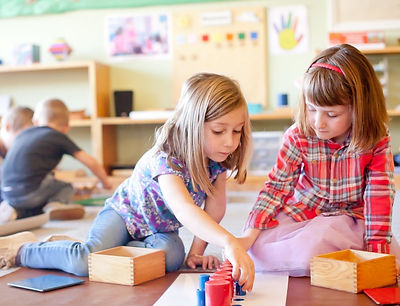

The Montessori Method
"Students are encouraged to make choices in order to develop a sense of independence and self-worth. Our classroom materials provide concrete learning experiences and the joy of discovery."
Learning
Traditionally, Montessori programs offer half and full-day instruction. Monarch Montessori offers a full-day program for infants & toddlers (6 weeks to 24 months) and half and full-day programs for all other students.
We promote a full instructional day. Learning takes place between
8:00 AM and 5:30 PM.
As a result, we do not require homework for our Day School students. We prefer that our families have a few extra hours to play, read and relax together!
Within the framework of the Montessori philosophy, all students regardless of age, are encouraged to learn at their own pace in a cooperative environment. Self-discipline and self-determination are key components of the Montessori learning philosophy.
The Montessori Classroom is designed to offer students opportunities to develop their capabilities including effective communication, multiplication using developmentally-appropriate manipulatives and problem-solving.
As children mature, the curriculum intentionally provides small group instruction and collaborative activities. The combination of independent, partner, small-group, and whole-group lessons and activities introduces children to different learning relationships and interpersonal dynamics—valuable skills for their interactions outside the classroom (AMI, 2020).
About Montessori
Maria Montessori was an Italian physician, educator, and innovator, acclaimed for her educational method that builds on the way children learn naturally. This is a method of education stresses the development of a child's own initiative and natural abilities, especially through practical play. This method allowed children to develop at their own pace and provided educators with a new understanding of child development. Students learn through activities that involve exploration, manipulations, order, repetition, abstraction, and communication, reasoning, imagination and creativity.
She opened the first Montessori school—the Casa dei Bambini, or Children’s House—in Rome on January 6, 1907. Subsequently, she traveled the world and wrote extensively about her approach to education, attracting many devotees. There are now thousands of Montessori schools in countries worldwide.
Guides
Montessori guides (teachers) are trained in child development and determining the needs of each child through observation. Guides are trained in both Montessori curriculum and philosophy.
Guides ensure that the classroom is non-competitive. Your child will work at his own pace and will choose the activity he works on.
Guides set up 5 areas in each classroom or group setting.
-
The Language Area
-
The Sensorial Area
-
The Math Area
-
The Cultural Studies Area
-
The Practical Life Area

_edited.jpg)


